[Korat] Phimai Historical Park
|
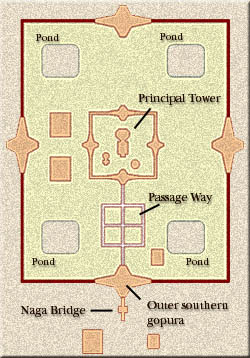 Phimai, the largest ruins of Khmer in Isan. It's a wonderful tourist spot
to visit. Phimai, the largest ruins of Khmer in Isan. It's a wonderful tourist spot
to visit.
This place was built as a Hindu temple in 12 century and was in the Kingdom
of Angkor ruled by Khmer people.
(I heard that it had been converted to a Buddhism temple by Jayavarman
VII (king of the Khmer Empire) later.)
Only the center of the site is now shown as a historical park, surrounded
by the walls, 1020 meters (north and south) by 580 meters (east and west).
From the size, it is said to be a critical site next to the capital of
Khmer Empire.
This temple is protected by two curtain walls, and you will see the entrance
of the outer wall (Outer southern gopura (porch)) when you enter the park.
After the outer southern gopura, the typical Khmer-style prangs will be
shown. In a prang, the Buddha image (reproduction) sits training himself
with his hands together.
Now, here we go ! :) |
The Gate (Outer southern gopura)
|
After entering the park, you will see the gate (Outer southern gopura).
There are four gates at each of north, south, east and west, and it seems
this southern gopura is the largest one in the four gates. There is a bridge
called " Naga Bridge " before the gate.
Including this bridge, this gate itself is outstanding and I thought this
one was a sanctuary or something like that at first. (I got to know this
was a gate later. :D ) |
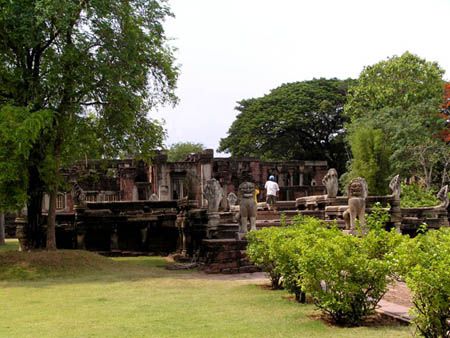
Gate 1
(After the entrance, you will see a ruin with atmosphere.)
|
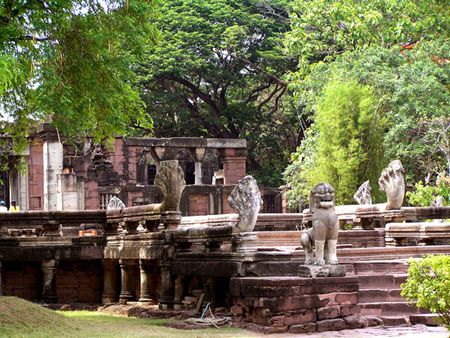
Gate 2
(Close-up of the gate.)
|
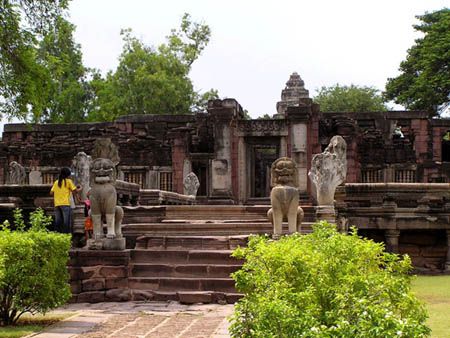
Gate 3
(Another angle of the gate.)
|
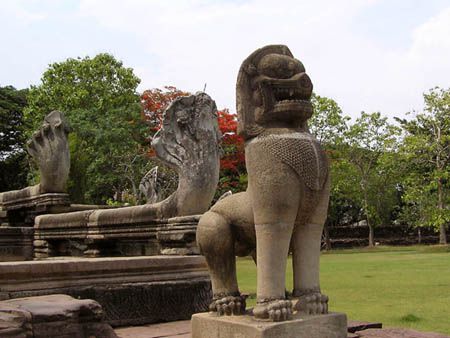
Sing
(Lion figure (Sing) in front, guarding the Naga Bridge.)
|
Gate 1
(After the entrance, you will see a ruin with atmosphere.) |
Gate 2
(Close-up of the gate.) |
Gate 3
(Another angle of the gate.) |
Sing
(Lion figure (Sing) in front, guarding the Naga Bridge.) |
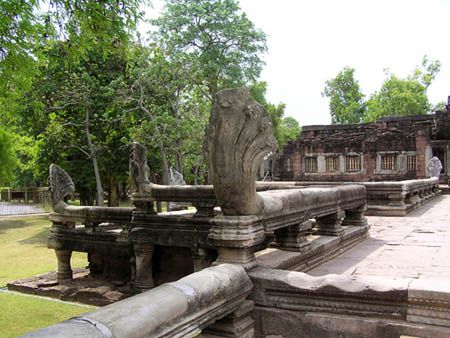
Naga (Snake God)
(It's broken but a guardian deity with several heads of snake.)
|
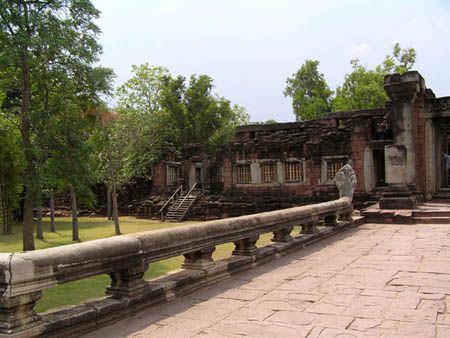
Naga Bridge 1
(Naga Bridge, leading to the gate over there.)
|
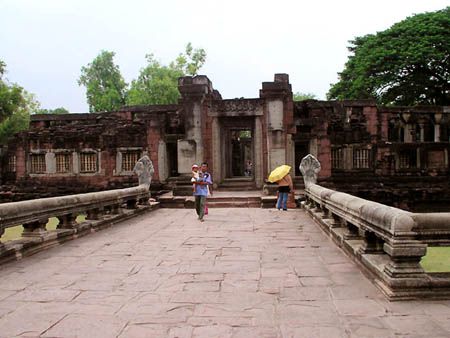
Naga Bridge 2
(In front of the gate.)
|
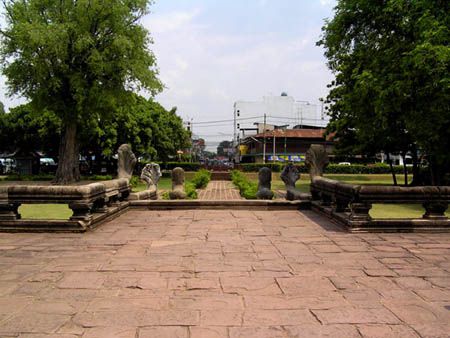
Naga Bridge 3
(Looking back to the entrance of the park from the Naga Bridge.)
|
Naga (Snake God)
(It's broken but a guardian deity with several heads of snake.) |
Naga Bridge 1
(Naga Bridge, leading to the gate over there.) |
Naga Bridge 2
(In front of the gate.) |
Naga Bridge 3
(Looking back to the entrance of the park from the Naga Bridge.) |
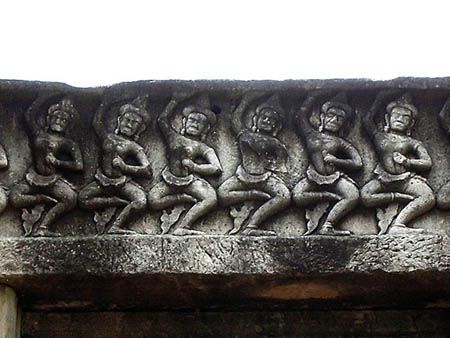
Gate 4
(Dancing figures on the front door of the gate.)
|
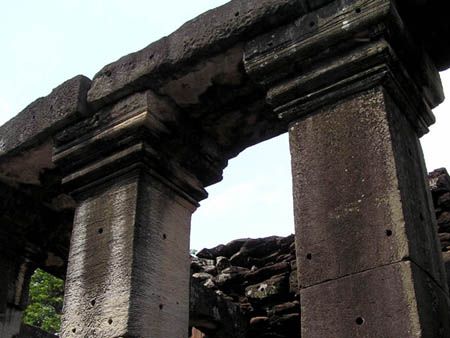
Gate 5
(Big columns are in lines, supporting roof stones.)
|
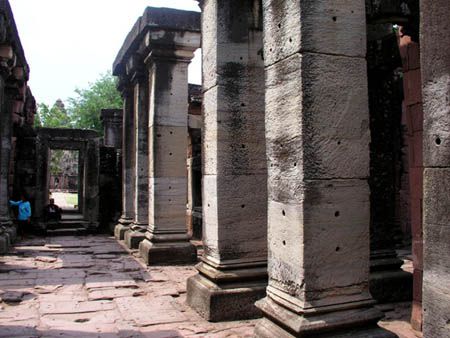
Gate 6
(There is a room in the center and two rooms next to it... ?)
|
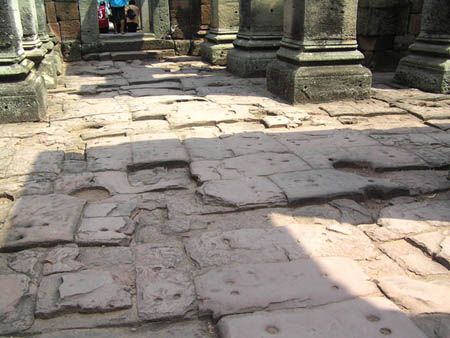
Gate 7
(The stone floor. It shows signs of wooden columns or something.)
|
Gate 4
(Dancing figures on the front door of the gate.) |
Gate 5
(Big columns are in lines, supporting roof stones.) |
Gate 6
(There is a room in the center and two rooms next to it... ?) |
Gate 7
(The stone floor. It shows signs of wooden columns or something.) |
[Phimai] Passage Way
|
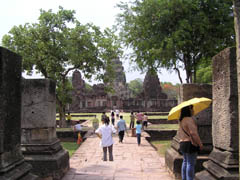
After passing the awesome gate (Outer southern gopura), you will see the
typical Khmer style prangs (chedis), Prasat Phimai.
They are spectacular and very beautiful.
After passing the awesome gate (Outer southern gopura), you will see the
typical Khmer style prangs (chedis), Prasat Phimai. They are spectacular and very beautiful.
You might see " Khmer style " in guide books so often but I feel
I can understand what it looks like while looking at the architecture
of the temple with three prangs (stupa). This kind of shape like sweet
corn is Khmer, right ? :)
Although the shape is a little different, but the temple " Wat Sri Sawai " (or Wat Si Sawai), in Sukhothai Historical
Park is also in the Khmer style. |

Passage Way 1
(From here to the prang in the center is the Passage Way.)
|
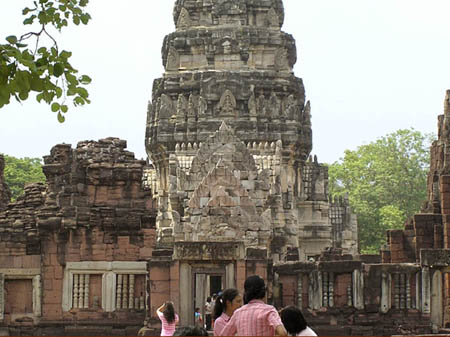
Chedi (prang)
(Close-up of the prang in the center.
A lot of Buddha images are sculpted.)
|
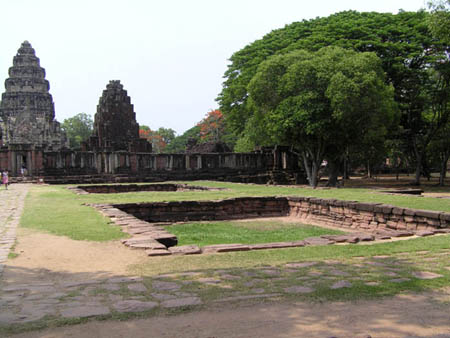
Passage Way 2
(This is called "Post hole" along the Passage Way.
I wonder if some buildings were here or not.)
|
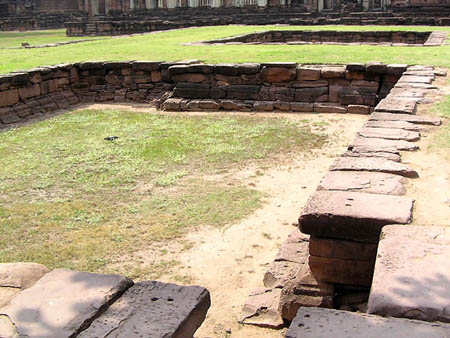
Passage Way 2
(This is called "Post hole" along the Passage Way.
I wonder if some buildings were here or not.)
|
Passage Way 1
(From here to the prang in the center is the Passage Way.) |
Chedi (prang)
(Close-up of the prang in the center.
A lot of Buddha images are sculpted.) |
Passage Way 2
(This is called "Post hole" along the Passage Way.
I wonder if some buildings were here or not.) |
[Phimai] Mahayana Buddhist Sanctuary - Prasat Phimai
|
Now, you've reached the sanctuary, " Prasat Phimai " after the passage way.
Are you ready ? :D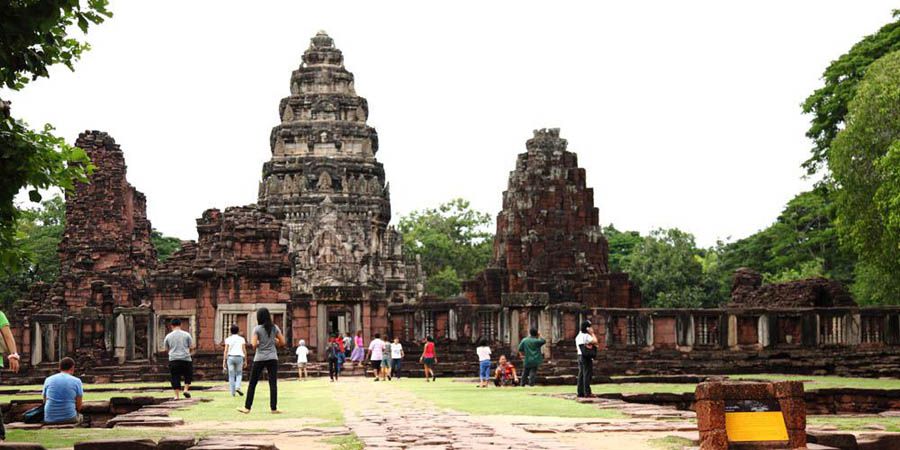
Now, you've reached the sanctuary, " Prasat Phimai " after the passage way.
Are you ready ? :D
An explanation board says;
- Prasat Phimai, which is a Mahayana Buddhist Sanctuary, is situated in Phimai District, Nakhon Ratchasima Province. " Phimai"
is the same word as " Vimai " which appears in the Khimer(I guess
Khmer) script stone inscription found on the door frame of the entrance.
Phimai is a large rectangular ancient city surrounded on all sides by moats
and boundary walls.
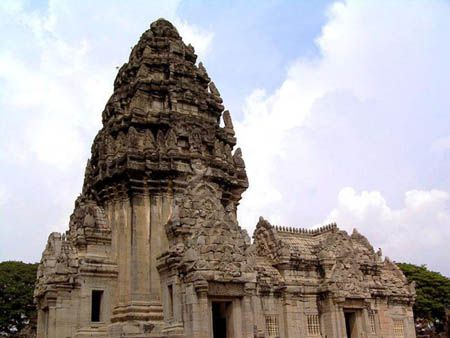
The construction of Prasat Phimai commenced in the 11th - 12th centuries
A.D., with additions during 13th century. These dates are based on evidence found in stone inscription. The archaeological
and artistic features of Prasat Phimai differ from those found in other
stone sanctuaries. While most of them face east, Phimai faces southeast, the direction of Angkor capital of the ancient
Khmer Empire.
The principal tower, Prasat Phimai, is situated in the center of the city. The Mun river passes on the northern and eastern sides while the Khem
stream passes on the southern side. The Chakarat Stream passes on the western
side and enters the Mun River at the Songkhran. The ponds, Sa Kaew Sa Phlung
and Sa Khwan, are located inside the walls of the ancient city, while the
ponds Sa Phleng, Sa Bohd and Sa Phleng Haeng are located outside. There
is also a large reservoir to the south.
The construction of Prasat Phimai commenced in the 11th - 12th centuries
A.D., with additions during 13th century. These dates are based on evidence found in stone inscription. The archaeological
and artistic features of Prasat Phimai differ from those found in other
stone sanctuaries. While most of them face east, Phimai faces southeast, the direction of Angkor capital of the ancient
Khmer Empire. -
|

The front of inner gopura
(The Sanctuary has a corridor around it, and animal-like guardians are
carved.)
|
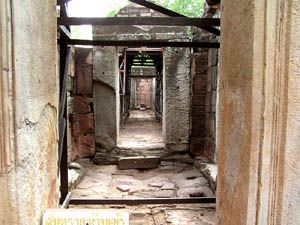
Enter the gopura
(A passage goes around but unfortunately, no one can enter.)
|
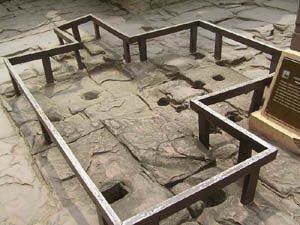
Auspicious Hole in the corridor
(Made in order to place auspicious objects when the temple was constructed.
They are now displayed at the Phimai National Museum.)
|
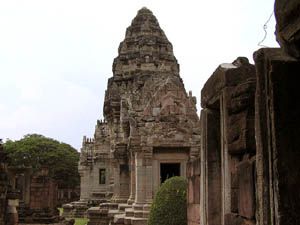
The principal tower
(The front of Prasat Phimai.)
|
The front of inner gopura
(The Sanctuary has a corridor around it, and animal-like guardians are
carved.) |
Enter the gopura
(A passage goes around but unfortunately, no one can enter.) |
Auspicious Hole in the corridor
(Made in order to place auspicious objects when the temple was constructed.
They are now displayed at the Phimai National Museum.) |
The principal tower
(The front of Prasat Phimai.) |
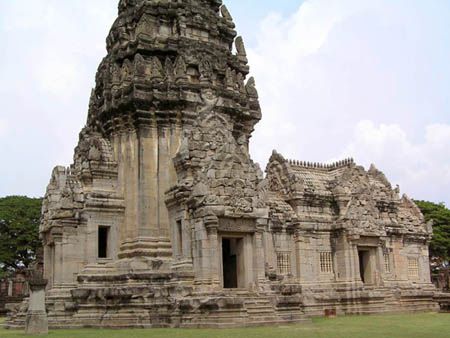
The side view of the tower
(The under side of Prasat Phimai.
A few entrances can be seen.)
|
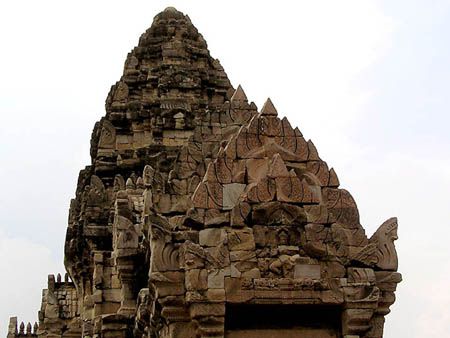
The upper side
(A human shaped object is carved at the front of it.
The god, Shiva of Hinduism ?)
|
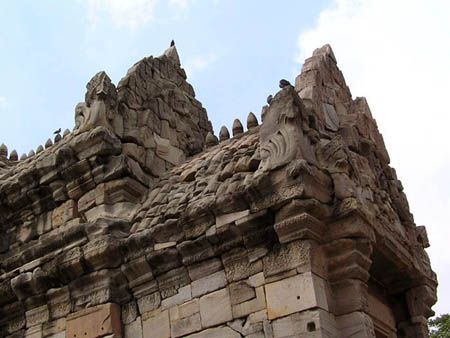
Another angle 1
(It has various decorations.)
|
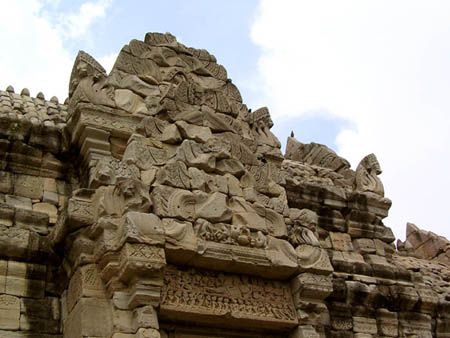
Another angle 2
(It has various decorations.)
|
The side view of the tower
(The under side of Prasat Phimai.
A few entrances can be seen.) |
The upper side
(A human shaped object is carved at the front of it.
The god, Shiva of Hinduism ?) |
Another angle 1
(It has various decorations.) |
Another angle 2
(It has various decorations.) |
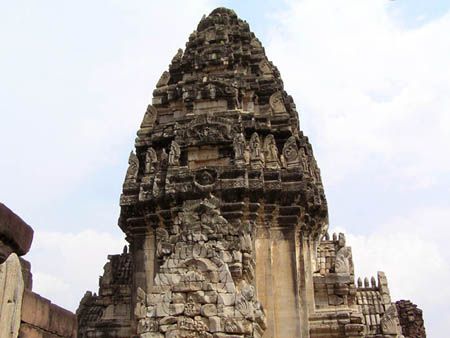
Another angle 3
(If you take a look carefully, you'll see a lot of Buddha statues are carved.)
|
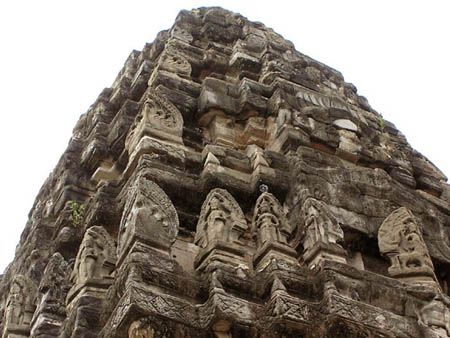
Close-up
(A lot of Buddha statues are carved around.)
|
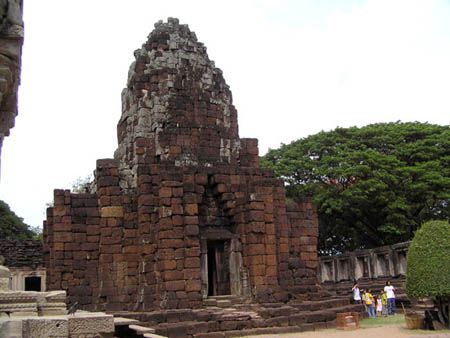
Brahmadat
(Another building, Prang Brahmadat in laterite, in front of the main pagoda,
on the right from the front.)
|
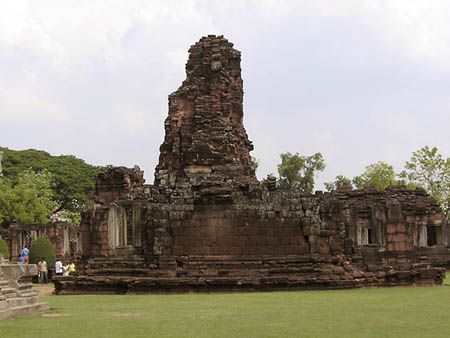
Ho Phram (Brahma Hall) and Prang Hin Daeng
(Another prang on the left from the front.
I'm not sure but it was the center of Brahmanism.)
|
Another angle 3
(If you take a look carefully, you'll see a lot of Buddha statues are carved.) |
Close-up
(A lot of Buddha statues are carved around.) |
Brahmadat
(Another building, Prang Brahmadat in laterite, in front of the main pagoda,
on the right from the front.) |
Ho Phram (Brahma Hall) and Prang Hin Daeng
(Another prang on the left from the front.
I'm not sure but it was the center of Brahmanism.) |
[Phimai] Inside of Prasat Phimai
|
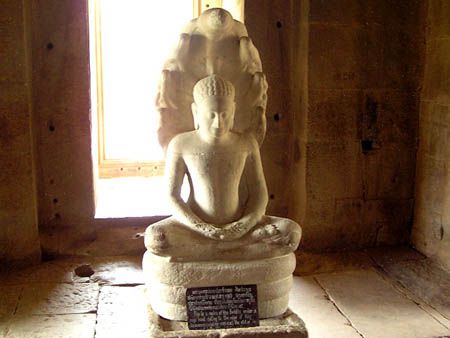
A white Buddha image is housed inside. This is a replica and the original
one seems to be in the Phimai national museum.
This part shows the inside of Prasat Phimai.
A white Buddha image is housed inside. This is a replica and the
original one seems to be in the Phimai national museum.
It's said that this was made around 1181 to 1220 in the era of King
Jayavarman. |
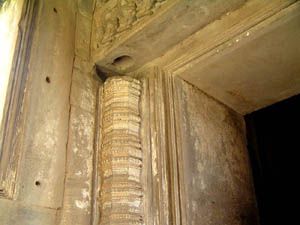
Wall
(Fine patterns are carved.)
|
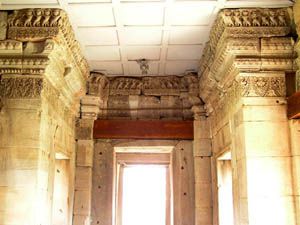
Ceiling
(Ceiling has fine patterns.
There is a security camera for the Buddha image.)
|
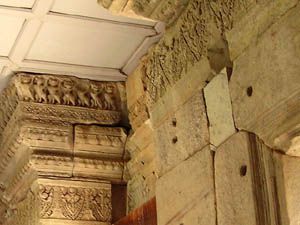
Ceiling
(Ceiling has fine patterns.
There is a security camera for the Buddha image.)
|
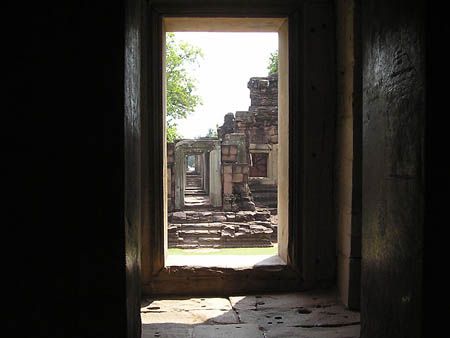
Path
(The path goes to another building.)
|
Wall
(Fine patterns are carved.) |
Ceiling
(Ceiling has fine patterns.
There is a security camera for the Buddha image.) |
Path
(The path goes to another building.) |
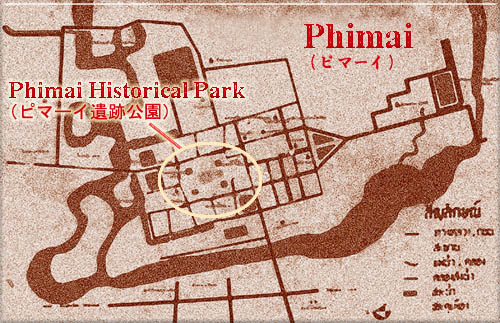 Now, let's see what it looks like. :)
Now, let's see what it looks like. :)
 After passing the awesome gate (Outer southern gopura), you will see the
typical Khmer style prangs (chedis), Prasat Phimai. They are spectacular and very beautiful.
After passing the awesome gate (Outer southern gopura), you will see the
typical Khmer style prangs (chedis), Prasat Phimai. They are spectacular and very beautiful.



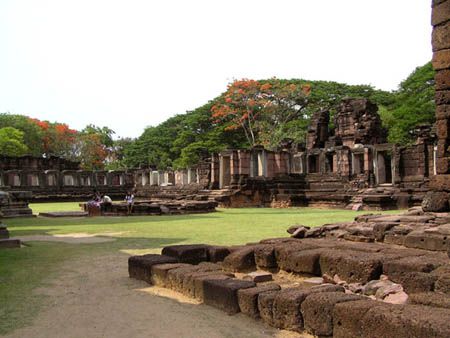 Scenery around Prasat Phimai.
Scenery around Prasat Phimai.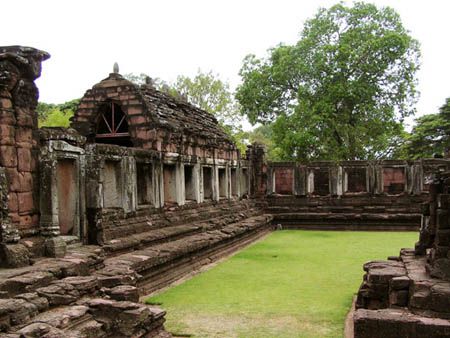
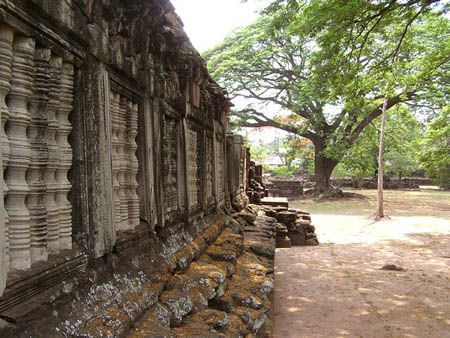
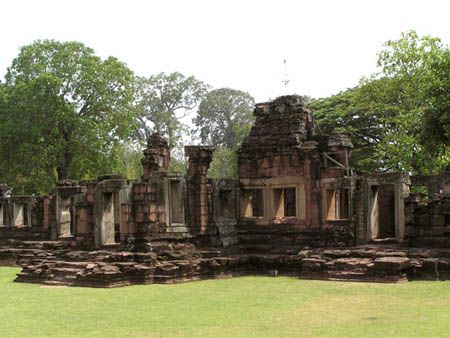
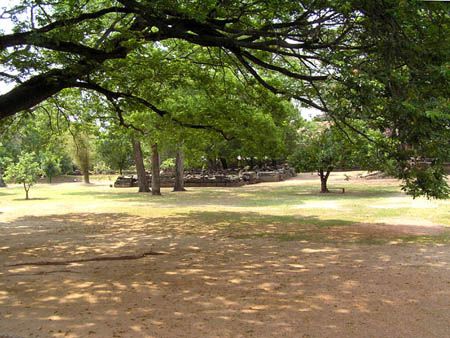
 Phimai, the largest ruins of Khmer in Isan. It's a wonderful tourist spot
to visit.
Phimai, the largest ruins of Khmer in Isan. It's a wonderful tourist spot
to visit.






























